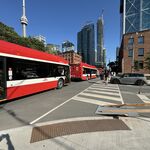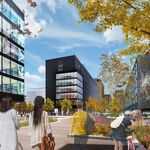GO rail usage in Toronto itself is very low precisely because it is too expensive. Also even including the 905 GO rail's ridership levels are nothing to brag about.
Compared to other North American commuter rail services, GO ridership is actually pretty good. Average per-train fullness is fuller than almost any other North American commuter train services, including Chicago and New York City.
The GO system is still overwhelmingly commuter, however, offpeak Lakeshore trains have far more non-work-commuters today than there used to be. Even if the trains are only a quarter-full, 80% of the people on an offpeak lakeshore train (several hundred people) include the mall-shoppers, family-groups, students, family visitors, and clientile that did not exist five years ago (pre-30-min Lakeshore service).
With further upgrades to GO RER, short-distance urban fare reductions (introduced by the SmartTrack GO RER line), the system will still be overwhelmingly commuter during peak much like TTC subway is. But offpeak usage of GO RER will slowly begin to roughly resemble TTC subway users (even if not completely due to the different demographics along a GO RER line, it will
look a lot closer to subway clientile (relative to today) than peak commuter clientile.
If you frequently ride offpeak Lakeshore GOtrains nowadays, in addition to peak GOtrains, you'll notice a very distinct different flavour of clientile than the usual GOtrain:
...Offpeak Lakeshore trains nearly empty between Aldershot-Oakville, as it accumulates people towards Union
...Offpeak Lakeshore trains approximately one-quarter-full to slightly-more-than-half-full by Union (except during holiday & events, then full)
...But that's still several hundred people total (from the looks, it looks sufficient to make sense farebox-wise for that traintrip)
...And the demographics of that train is now very different from a peak-period GOtrain.
...I've now occasionally seen offpeak/holiday GOtrains become near-full by Union (80-90%+) with near zero business suits while the day was still bright (so it wasn't a Leafs game or specific event). One of these happened on was Boxing Day.
Demographics include:
- More families / more casually dressed people (fewer business suits)
- More Mall shopping bags (E.g. from Eaton Centre shops, etc)
- More backpack users (suggestive of students)
- Event-times are now heavier than they have in the past -- holiday weekends, hockey, Ex, stadium events, major plays, etc. -- as people nowadays have less fear of "missing the last train". Also, service now shuts down for only approximately 5.5 hours on Lakeshore (from the 12:43am train departing Union followed by the 6:13am train departing Union) and additional trains are often added overnight during major overnight events like Nuit Blanche.
The apparent demographics of an offpeak Lakeshore GOtrain has evolved dramatically, and I think the average Lakeshore commuter ratio fell dramatically from 98% work-commuter to maybe only 80% work-commuter (due to much more frequent offpeak service). That's still many thousands of additional GO users, and the transition to 15-minute GO RER will push GO demographics to look a little more like a TTC subway (maybe slightly higher-end version of TTC subway demographics, but far different from a peak-period GO train).
When going to 15-minute service, I imagine that some GO RER routes will likely be better served by single-decker trains during offpeak. The frequent service means 12-car-bilevels will probably not be efficient for 15-minute-offpeak-frequency routes. But the bilevels can in theory run that frequently, if push came to shove -- Lakeshore West has 6 trains departing Union between 5:00pm and 5:45pm -- and the signalling along Union corridor hasn't yet been upgraded. Likely they'll still use them mixed with offpeak allstop EMU trains, running bilevels with the electric locomotives, especially for the express trains where EMU acceleration matters less.




